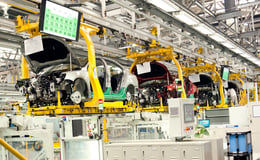Tracking Emissions in Your Supply Chain
Nicole Wanichko - March 11, 2021

Implementing sustainable business practices in your company is now more critical than ever. As the world struggles to fight an ongoing climate crisis, new environmental standards for businesses are continually being made and enforced. Supply chains account for more than three-quarters of greenhouse gas (GHG) emissions of an associated industry. As a result, regulations on emissions are getting stricter, and businesses feel the pressure to become more sustainable. But, legal requirements are not the only reasons that it is crucial to implement green practices. If you do not track your emissions, you cannot reduce them. By transitioning into a greener business, you are saving yourself time and money – while doing your part for the environment. There are countless benefits to transitioning to a greener supply chain, and we will provide you with the tools to achieve it through tracking and managing your supply chain emissions.
Why It Matters
Brand Image
Not only is tracking and managing your supply chain emissions beneficial to the environment, but it is also beneficial to your brand. More and more, an organization's sustainability and environmental practices hold heavy weight on its reputation. Customers may be less inclined to use your company's services if they are openly unsustainable. Additionally, even associating with less environmentally-friendly suppliers can taint your organization's image, causing suppliers and customers to look elsewhere for their needs. You may ask, how will customers know what we are emitting? Increasingly, business customers are requesting companies to provide information on the life cycle emissions of the products and services they use. As a result, sustainability metrics are becoming increasingly vital for organizations to track. Your organization needs to have this information available and up to customer standards to ensure credibility and a positive brand image. The best start to this is by tracking the emissions of your supply chain to manage them.
In addition to improving brand image in your customers' eyes, tracking and reducing carbon emissions will have your shareholders and employees impressed as well. As it is probable you will have to report your emissions, it is important to report metrics that everyone associated with your company can be proud to reveal. These reports can also be an excellent marketing tool that will excite customers and your competitors jealous. Overall, once you integrate sustainable practices into your organization, they will no longer become "practices," they will become part of who your company is.
Energy Price Volatility
In tracking and managing your organization's carbon emissions, you will also be insulating your supply chain from sudden spikes in energy and fuel prices. While it may seem costlier at first to reduce reliance on fossil fuels and unsustainable energy, you will be saving money in the long run. With the limited resource of fossil fuels, it is becoming increasingly expensive to obtain these resources. If your organization can transition to more environmentally friendly energy resources, such as solar polar or wind power, you will reduce your reliance on costly fuels and reduce your exposure to their volatile prices.
Comply with Regulations
Another vital reason why tracking and managing your emissions is crucial to your business is that it simplifies complying with emission regulations. Following an executive order made in 2009, all federal agencies require companies to measure and reduce GHG emissions associated with their operations to reduce corporate carbon footprints. While some companies are only required to report operations to suppliers, others must publicly report their findings. This order set the tone for all businesses, which is evident as the government is continuously writing and updating regulations to hold corporations to a sustainable standard of operations.
The most efficient way to comply with regulations is to get ahead of them. By consistently tracking your organization's emissions, you will always be prepared to meet regulations. You will always be aware of your emission levels and be able to manage and reduce them perpetually. With a commitment to tracking your emissions, your organization will comply with and exceed regulations without fail.
Best Practices
Now that you understand the value in tracking your supply chain emissions, it is time to implement. The most efficient way to track emissions so that you can start cleaning up your supply chain is through the implementation of Industry 4.0 technology. As businesses become more and more digitally based, your organization must keep up to date with current technology. While Industry 4.0 is more of a concept than a tangible collection of technologies, it consists of basic ideas that will lead you to the right software and hardware for your organization's needs. These ideas include developing interoperability, which essentially is intertwining connectivity and visibility. This is crucial for tracking emissions as you must monitor every aspect of your supply chain's outputs simultaneously. This means that any individual practice you are implementing needs to be compatible with all other practices. Going off of this, you need information transparency in your supply chain. To achieve this, your organization needs access to systems that can easily exchange data in real-time, allowing you to adapt to changes and stay resilient. This is where analytics come into play. Once your systems are ready to provide clear and cohesive data, you need to analyze the information in a way that allows you to plan and act. AI and machine learning-driven analytics are excellent technologies for analyzing data in-depth, pinpointing the precise location in a supply chain that produces the majority of emissions so that you can make changes. Additionally, cloud capabilities are paramount in the future of supply chains, so ensure that your systems will be compatible.
Before putting your Industry 4.0 technology to work, it is important to plan so that you are ready to use your data strategically. To start, set emissions reduction targets for you and possibly your suppliers. At a minimum, set your target to meet global emission regulations, and once you achieve this, you may consider increasing these targets to reach further sustainability. You should measure these targets in two ways; absolute and intensity. Absolute targets will measure a percentage reduction of emissions from a base to a target year, and intensity targets will measure a percentage reduction devised in emissions per indicator from base to target year basis. Another excellent practice is reducing emissions through engagement targets. This entails influencing a specific set of actors in your supply chain to track and reduce their emissions, such as their suppliers. Suppliers are a significant factor in your organization, so you will benefit from their sustainability as well as your own.
The future of supply chains is sustainability. For your company to succeed in an increasingly green world of business, tracking and reducing your GHG and carbon emissions is vital. By understanding the need for and benefits of becoming a more sustainable business, you can implement these changes and improve the quality of your supply chain and your brand. By implementing Industry 4.0 technology such as cloud systems and AI, your supply chain will be working more efficiently than ever while becoming a part of a global community working to protect the environment.
Click on the image below to learn more about your carbon footprint.
LATEST POSTS
- Understand Why Production Planning Needs Specialized Solutions
- Understand Circular Economy in The Manufacturing Industry
- How Can Industry 4.0 IT Integration Be Achieved Smoothly?
- The Significance of Order Sequencing in Discrete Manufacturing
- How to improve your Supply Chain Management: The Power of Control Towers



